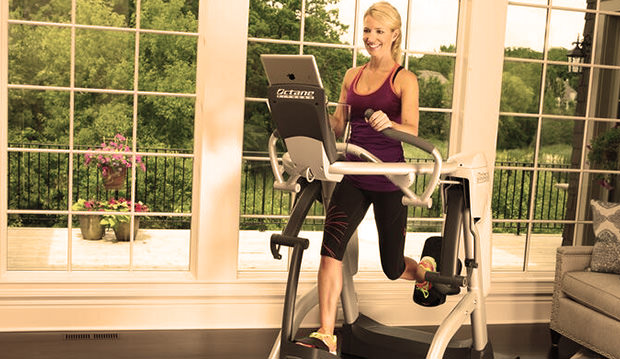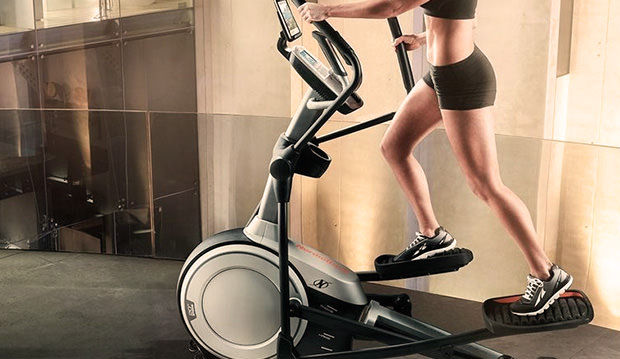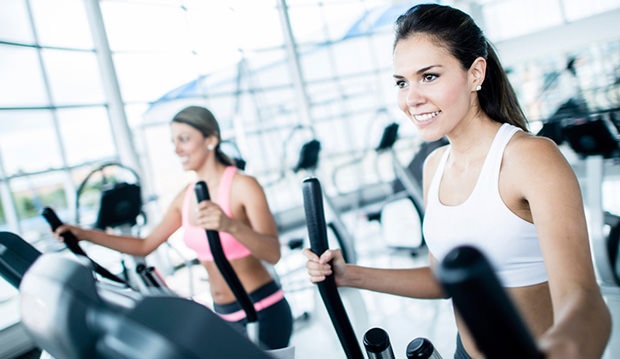
How To Use The Elliptical For Fat Loss

Posted on 22 Feb, 2021

The elliptical might just be the most used — and misused — piece of equipment at your gym. While the amount of calories you burn in any given elliptical workout depends on ramp height, resistance level and speed stride speed, you can burn usually burn about 270 to 400 calories in 30 minutes (see the sidebar for more info). And because your feet never leave the pedals, the elliptical provides a low-impact workout that is friendly to your joints and back, unlike a treadmill.
But if your goal is to get your heart rate high, work up a sweat and keep off excess pounds but all you’re doing is a steady 20- or 30-minute workout, you’re missing out on the machine’s potential.
“The elliptical is a powerhouse among cardio equipment because it allows you to use a large amount of muscle,” says Evan Johnson, a certified personal trainer in Storrs, CT. The machine builds strength and muscle endurance in the quads, hamstrings, glutes and calves, but also works your arms, chest and back when you actively use the handles. “The more muscles that are working, the more calories you’ll be burning,” he says.
Feel the (Caloric) Burn
 Not all cardio machines are created equal when it comes to the amount of calories you'll burn. Here's a list of the most popular cardio machines and how many calories you'll burn in 30 minutes.
Not all cardio machines are created equal when it comes to the amount of calories you'll burn. Here's a list of the most popular cardio machines and how many calories you'll burn in 30 minutes.
- Elliptical machine: 270 to 400 calories
- Stair stepper: 180 to 266 calories
- Stationary bike (moderate intensity): 210 to 311 calories
- Stationary bike (vigorous intensity): 315 to 466 calories
- Rowing machine (moderate intensity): 210 to 311 calories
- Rowing machine (vigorous intensity): 255 to 377 calories
- Ski machine: 285 to 422 calories
*Data from Harvard Medical School based on people raging from 125 to 185 pounds. Exact caloric burn is dependent on weight, fitness level and intensity (speed or incline).
Benefits of Using an Elliptical
 There are plenty of reasons to hop on an elliptical, but here are just a few:
There are plenty of reasons to hop on an elliptical, but here are just a few:
- Targets your glutes, quadriceps, hamstrings and calves in the lower body and your latissimus dorsi (lats), pectorals, triceps and biceps in the upper body.
- Pedaling an elliptical trainer can also help reduce mineral loss in the bones that bear your weight.
- Since your feet never leave the pedals, you don't have to tolerate the repeated pounding impact of each footfall on a treadmill. Thus, an elliptical workout is both quieter and more comfortable.
- You can adjust the resistance and incline of the elliptical and change your speed at will (unlike a treadmill) to either amp up your calorie burn or allow yourself more recovery time.
- When combined with a healthy diet and strength-training workouts, ellipticals can help you reach your weight loss goals. To lose one pound of fat, you need to be in a caloric deficit of 3,500, meaning you burn more calories than you consume. So depending on other factors, you can start to see small results within a week and more major changes within a month.
- Regular cardio workouts also reduce stress, improve your mood, boost your immune system and reduce your risk of developing obesity-related diseases.
The Elliptical vs. Other Cardio
 If you do the same workout over and over, the body adapts to it. Over time, you’ll burn fewer calories and maintain, rather than improve, your cardiovascular fitness. By mixing up your routine, you’ll burn more calories and gain fitness faster. So even if your primary mode of cardio exercise is the elliptical, you'll want to beat the boredom (and the workout plateaus) by incorporating some of these other machines and cardio options into your routine. Here are the pros and cons of each of the alternatives.
If you do the same workout over and over, the body adapts to it. Over time, you’ll burn fewer calories and maintain, rather than improve, your cardiovascular fitness. By mixing up your routine, you’ll burn more calories and gain fitness faster. So even if your primary mode of cardio exercise is the elliptical, you'll want to beat the boredom (and the workout plateaus) by incorporating some of these other machines and cardio options into your routine. Here are the pros and cons of each of the alternatives.
STATIONARY BIKES
As another low-impact cardio machine, the stationary bike also allows you to sit while you workout, helping you maintain your balance and making it ideal for those with joint or back pain. But while you can adjust the resistance, you can't adjust incline or use the handle bars as you would in an elliptical.
OUTDOOR CYCLING
Taking your bike outdoors has the advantage of real-world challenges that you can't control like you do at the gym. There are hills and obstacles to take on, plus you have the added core stability challenge to make sure you stay on the bike. And overall, cycling is fairly low-impact. But again, beginners or those with joint issues should favor the elliptical, at least at first.
TREADMILL
Though the elliptical is great for beginners because your body weight is fully supported by the machine, the treadmill has the potential to scorch more calories for advanced runners, depending on your speed and incline. Seasoned runners will likely favor the treadmill, only mixing in the elliptical for cross-training. And because your body weight isn't supported on a treadmill, you'll get a higher-impact workout and build more bone density. However, the treadmill is solely a lower-body workout, while the elliptical features an upper-body component. Those who want a full-body cardio workout or those with joint issues should opt for the elliptical.
[Related: 20 Reasons Why The Treadmill Is Awesome]
OUTDOOR RUNNING
While the elliptical does mimic some of the movements of running in a more low-impact manner, running outdoors gives your muscles (especially your glutes, quads and calves) more of a challenge, as you're not plodding along on a machine. Plus, it means you're not tied to the gym. Unfortunately, it can be taxing on your ankles, knees and hips, so if you have injuries or weaknesses in any of these areas, stick to the elliptical.
[Related: 30 Convincing Reasons To Start Running Now]
STAIR CLIMBER
As long as you don't lean too heavily on the hand rails of the stair stepper, this machine can provide a great lower-body workout, targeting the glutes and quads even more than the elliptical. But like most other cardio options, the elliptical is still your best bet for the lowest-impact workout.
But if your goal is fat loss, the question isn't which machine will work best, it's which machine you'll work best on. Pick the option that you feel you can do the most fat-burning intervals on. Or see below for fat-burning elliptical workouts.
Practice Proper Form on the Elliptical
 First, there are a few things you should keep in mind during every elliptical workout. You’ll reap more benefits from your exercise sessions if you maintain proper form: Stand tall with correct posture, your head over your shoulders and your shoulders over your hips. To work the upper body, you must actively push and pull on the handles, not just hold on, says Johnson.
First, there are a few things you should keep in mind during every elliptical workout. You’ll reap more benefits from your exercise sessions if you maintain proper form: Stand tall with correct posture, your head over your shoulders and your shoulders over your hips. To work the upper body, you must actively push and pull on the handles, not just hold on, says Johnson.
But avoid grabbing the handlebars too tightly; doing so can fatigue the forearms and shoulders and tempt you to lean on the machine—a common mistake. Leaning can reduce the strengthening and fat-burning effects. Plus, over time, it can strain the shoulders and back.
As you exercise, watch your speed. Increasing your RPMs (revolutions per minute; some machines may use SPM, or strides per minute) ups the intensity, but too much speed can get you into trouble. “Going too fast on the elliptical causes you use too much momentum, so your muscles are not fully engaged,” says Michele Olson, Ph.D., professor of exercise science at the University of Montgomery, Alabama and faculty at the American College of Sports Medicine.
In other words, excess speed, like leaning, cheats your legs out of some strengthening benefits and reduces the number of calories you burn. If you’re bouncing or your feet are coming off the pedals, slow down.
Elliptical Workouts to Take to the Gym
 To maximize your time on the machine, Johnson designed four workouts that use the elliptical’s multiple settings to target your whole body. Incorporate at least one workout into your weekly routine, or if you use the elliptical multiple times during the week, try a couple or more.
To maximize your time on the machine, Johnson designed four workouts that use the elliptical’s multiple settings to target your whole body. Incorporate at least one workout into your weekly routine, or if you use the elliptical multiple times during the week, try a couple or more.
These elliptical workouts employ effort levels that follow a 10-point rate of perceived exertion scale (one is very low intensity, 10 is all out effort). During the warm-up, cool down and rest intervals of each, let go of the handles. This gives your arms and upper body a rest but also engages the core and challenges your balance.
[Related: 11 Types Of Gym Goers You Will Find At The Gym]
High-Intensity Short Intervals (30 minutes)
Settings: Select the machine’s short interval program. If there isn’t one, use manual mode and control the resistance yourself. Set the incline (or ramp) at low to moderate (it won’t change for this workout). Instead, you’ll adjust the resistance to change the intensity.
- After a three-minute warm-up, follow the machine’s interval program (usually 30 seconds to two minutes). If you’re in manual mode, increase the resistance to an effort that feels like an eight or nine (on a perceived exertion scale of 10) for one to two minutes. Pushing and pulling on the arms handles will help you increase your RPMs.
- Reduce your intensity and slow your RPMs for a rest period that’s equal in length to your hard interval (for example, one minute hard, one minute rest). Your perceived exertion should be about a two or a three during this time.
- During every third hard interval, pedal backwards.
- Repeat intervals until you reach 27 minutes of total exercise time, and then cool down with three to five minutes of easy effort.
[Related: The Benefits Of High Intensity Interval Training]
Hill Climber (45 minutes)
Settings: Choose a “Hill” program that gradually increases resistance and incline height over two to five minutes, and then provides a rest period. Most machines will offer four to six hill repeats per workout.
After your warm-up (three to five minutes), do the first hill and note the total time. For the other intervals, divide the hills in half and do the following:
- For the first half of the hill, keep your hands on the middle of the swinging arm handle, which targets the lower back muscles (it mimics rowing).
- In the second half, grab the top of the handles and really put forth effort in your pushing and pulling. Your effort level should be up to eight by the end of the interval. If you’re having a tough time towards the end, lean forward and press down hard to get up over the hill
Continue up the hills until you reach about 40 minutes of total exercise time. Cool down for five minutes.
“Mile Repeats” or Mid-Intensity, Long Intervals (45 minutes)
Setting: Manual. You’ll increase your intensity by adjusting the ramp and your RPMs.
After the warm-up (three to five minutes), perform five five-minute intervals at an effort level around six or seven. Use the following settings:
- Low ramp, low resistance, high RPM
- Medium ramp, low resistance, high RPM (pedal backward)
- High ramp, low resistance, high RPM
- Medium ramp, low resistance, high RPM
- Low ramp, medium resistance, high RPM (pedal backward)
Between each interval, recover with three minutes at a moderate intensity (effort level four to five) by slowing your RPM. Cool down with an easy three to five minutes.
The Ladder (60 minutes)
Setting: Manual. You’ll increase your intensity by adjusting the ramp and resistance.
Warm-up for five min easy with your hands swinging free. You’ll then perform three 15-minute intervals. During those intervals, you’ll increase the intensity every five minutes by doing the following:
- First five minutes: low ramp, low resistance (effort level five to six)
- Second five minutes: medium ramp, medium resistance (effort level six to seven)
- Last five minutes: high ramp, high resistance (effort seven to eight)
- After completing the first 15-minute interval, stride easy for two minutes, then get off the machine and do 25 body-weight squats.
- Get back on and perform the second interval (same structure as above). Then stride easy for two minutes, get off the elliptical and complete 25 body-weight lunges.
- Return to the machine and do the third interval.
- Cool down with five minutes of easy strides, letting your arms swing free. If you have any energy left, knock out 25 more body-weight squats when you get off the machine.
Tips for Using the Elliptical

- The best shoes for the elliptical are either running shoes or cross-trainers, and they'll fit your foot properly while offering plenty of arch support, stability and cushioning. Shoes made for road running, which are generally light and flexible and primarily designed for flat surfaces, are optimal over trail-runners for the elliptical’s even-tread pedals. Cross-trainers are usually designed with wide and stable outsoles to provide stability and support for your feet and ankles. Cross-trainers can lack cushioning, which makes them a poor choice for actual running, but the shoes work well on the low-impact elliptical.
- There are several different types of "ellipticals": Elliptical trainers are lower-body-only cardio machines that has foot pedals you stand on and a stationary handlebar to hold onto. The elliptical cross-trainer is a cardio machine that works the upper and lower body. It has the same pedal platforms as the elliptical trainer, and moves in the same elliptical pattern. An elliptical glider looks very much like an elliptical trainer, however, the pedals move up and down at a slight backward angle.
- Consult your doctor before beginning any new weight-loss regimen, especially if you have injuries that would make using gym equipment dangerous.
Great Books To Keep You In Shape

by Alex Hutchinson

by Matt Fitzgerald

by Tom Venuto

by Liz Price-Kellogg
 How To Work Out Less And Still Look Younger
How To Work Out Less And Still Look Younger Do You Really Need Cardio Workouts?
Do You Really Need Cardio Workouts? Cardio For Very Busy People
Cardio For Very Busy People How To Do The Perfect Plank
How To Do The Perfect Plank










